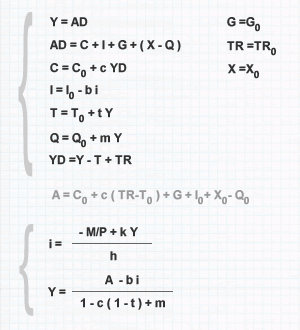IS-LM Model
The IS-LM model stands as a pivotal macroeconomic framework for evaluating the interplay between monetary and fiscal policy in shaping aggregate equilibrium income within an economy. This analytical model integrates the dynamics of interest rates and national income across two critical markets: the LM curve representing the monetary sector, and the IS curve depicting the goods market. Distinctively, the IS-LM paradigm departs from traditional notions of exogenously determined investment, placing emphasis on the influence of interest rates in modulating both investment demand in the goods market and liquidity preference in the monetary sector. This dual analysis facilitates a comprehensive determination of equilibrium levels for both interest rates (i) and national income (Y).

A graphical exposition of the IS-LM model elucidates the equilibrium interest rate and income combinations that concurrently stabilize the goods and monetary markets. The principal components of the IS-LM structure include:
- IS Curve: This curve maps the equilibrium points in the goods market, reflecting the relationship between variations in interest rate (i) and aggregate income (Y).
- LM Curve: This curve delineates the equilibrium in the monetary sector, correlating changes in interest rate (i) with shifts in national income.
The confluence of the IS and LM curves signifies the nexus of equilibrium in the IS-LM model, harmonizing the goods and monetary markets. This model is especially adept at dissecting the ramifications of fiscal and monetary policies, tracing their transmission through both markets until a new equilibrium stance is attained.
 Income-Expenditure Model: The IS-LM model extends the theoretical contours of the income-expenditure model. The divergence primarily lies in the investment function: while the income-expenditure model treats investments as exogenous, determined by long-term corporate forecasts, the IS-LM model regards them as responsive to prevailing interest rates, thereby linking them directly to investment financing costs.
Income-Expenditure Model: The IS-LM model extends the theoretical contours of the income-expenditure model. The divergence primarily lies in the investment function: while the income-expenditure model treats investments as exogenous, determined by long-term corporate forecasts, the IS-LM model regards them as responsive to prevailing interest rates, thereby linking them directly to investment financing costs.
 Resource Underutilization: Within the IS-LM framework, equilibrium income (output) is co-determined with the interest rate. This equilibrium income often does not equate to full resource utilization, typically falling below the potential output level. This gap underscores the strategic role of economic policy in augmenting income and aggregate demand, thereby reinforcing the IS-LM model's utility as a strategic analytical tool for economic policy design and assessment.
Resource Underutilization: Within the IS-LM framework, equilibrium income (output) is co-determined with the interest rate. This equilibrium income often does not equate to full resource utilization, typically falling below the potential output level. This gap underscores the strategic role of economic policy in augmenting income and aggregate demand, thereby reinforcing the IS-LM model's utility as a strategic analytical tool for economic policy design and assessment.

